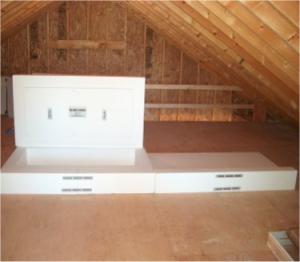- 1 read

A growing number of homeowners and all energy saving experts know that the attic entrance is a big energy loser in both summer and winter. It is simple — most attics are insulated to R-38 or higher to stop conductive heat loss. Equally important, the rest of the attic is air sealed to stop convective heat loss. The attic entrance typically has R-0.4 insulating value and air leaks comparable to a window left slightly open. This stark contrast to the air sealing and insulating value for the rest of the attic results in a costly waste of heating and air conditioning costs.
To date, the bar has been set very low to address the attic entrance. The all too common standard has been: “Something is better than nothing.” Custom constructed solutions often consist of a little weather stripping and some fiber glass or rigid insulation glued to the back of the hatch or knee wall access or a box like structure over a pull down ladder. These were considered to be better than nothing and accepted by far too many in the field. There are several commercially available kits that offer insulating values ranging from R-3 to R-13 with little or no air sealing. Until now the conventional wisdom was accepting of these sub-standard solutions. Some respected experts in the field believed that since the attic entrance is such a small part of the overall building envelope; it doesn’t warrant anything better. Not anymore!
The building science has proven that the attic entrance is just as important as any other part of the attic. It is a vital part of the building envelope — the insulation and air sealing that stands between you and the outdoor conditions. Doing a little something to stop the energy loss may be better than nothing, but it is no longer good enough.
New Code
This year, both the 2009 International Residential Code (IRC) and the International Energy Conservation Code (IECC) mandated specific standards for all attic entrances. These new standards require that all attic accesses must contain:
- Insulation equivalent to the rest of the attic
- A durable air seal
- A wood or equivalent barrier built around the attic entrance in the attic to prevent insulation from falling into the living area
- Insulation for this measure must be non compressible
Prior to the 2009 releases of these codes, there were no specific standards for any attic entrance. These new code requirements provide no wiggle room and are a product of the best minds in the area of energy conservation. It is crystal clear what needs to be done to stop the energy loss for all attic entrances. There is no longer any room for interpretation.
The IRC and IECC are being implemented in many state programs and code requirements. While some states will be slower to implement these standards than others, the science discussion has been resolved. Mandatory adherence to these standards is simply a matter of time.
Clearly, it will require more materials and time to build a measure that meets the new standards. Every homeowner who has work done on their home should be aware of what they need done by any contractor, insulation company or builder. You may need to refer them to the above code and remind them that the old standard of “something is better than nothing” just doesn’t cut it any more.
For homeowners and contractors, there is good news. There is one commercially available kit available, The Energy Guardian® Kits, produced by ESS Energy Products, Inc. ESS makes kits for every type of attic entrance that meet or exceed the code requirements. For more information, go to www.essnrg.com.

